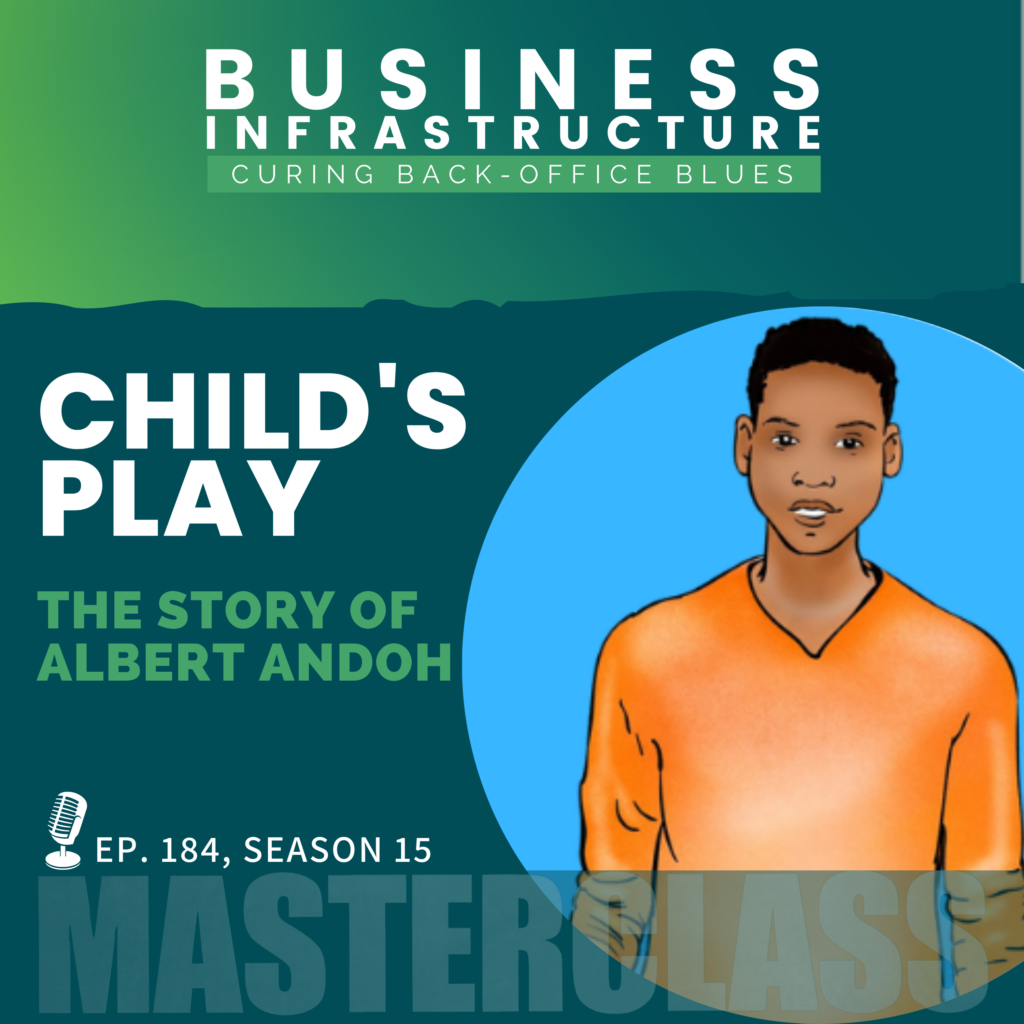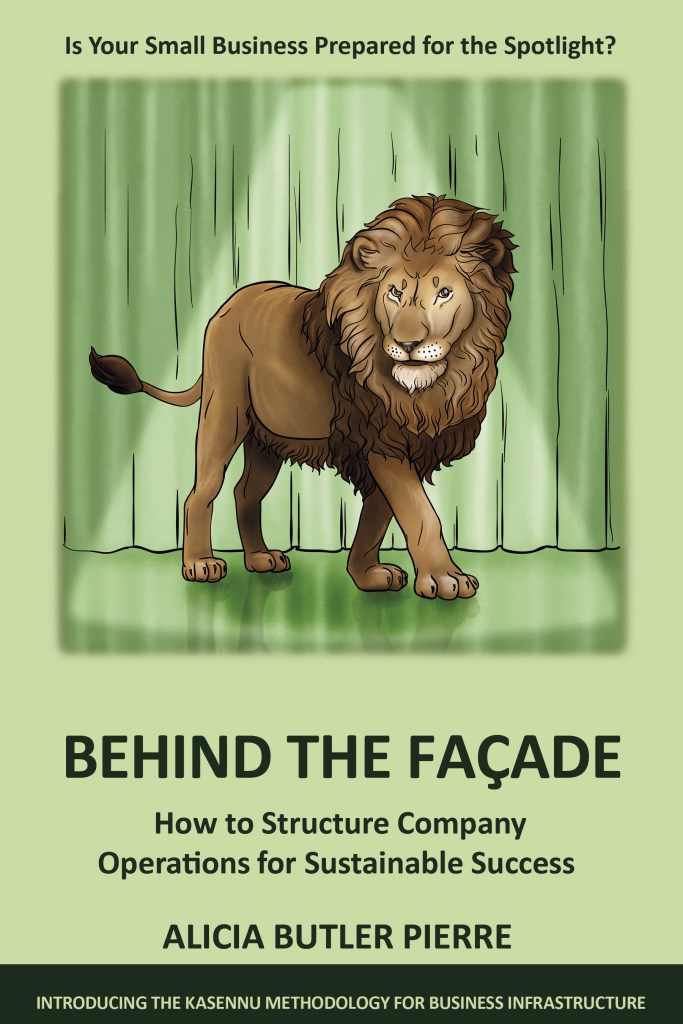Transcript
Welcome back! We’ve completed the first lesson on building business infrastructure. At this point, you’ve heard the story of Emily Miller, her fast-growing non-profit, and how she used a Business Parts Analysis to position the organization for sustainable scale. You’ve also learned how to create one for your own organization, as well as the associated benefits and how it results in a defined structure, hiring strategy, and job descriptions to support future growth.
If you haven’t listened to these episodes, then make sure you do because they contain information that sets the foundation for the lessons you’ll learn in the remaining episodes this season.
Now it’s time to meet our next entrepreneur. Or should I say, kidpreneur. His name is Albert and he’s about to find out how an organizational chart can prove capacity and scalability.
This is episode 184. Child’s Play – the Story of Albert Andoh and the Emerging Tech Startup
Albert Andoh has a golden opportunity to take his young software development company to the next level. Investors are currently courting him to help make that possible. His company’s growth is steady and is predicted to skyrocket once he appears at a popular technology conference. With all his success, there’s just one problem. He’s still in high school.
The investors are concerned about his age — they need assurance that: 1) they’re not placing over a half-million dollars into the hands of a child, 2) there’s a sustainable growth plan in place and, 3) experienced, capable adults, are running the company. A chance encounter at the conference leads him to working with a consultant who introduces him to another element of building business infrastructure — the Business Design Blueprint.
***
It was 11:15 am. Not even drawn shades could prevent the sun’s rays from beaming throughout the classroom. The stillness in the room was only broken occasionally with the sounds of birds tweeting; a welcomed reminder that in two more weeks, spring would officially arrive. The proctor almost lost herself in daydreaming. She was already thinking about her plans for the weekend.
For the past three hours, she sat in the back of the classroom performing these periodic room scans, searching for potential cheating or other nefarious activities. The students were sitting in desks lined up in four rows, all facing the front of the classroom. As she continued scanning, her eagle eyes noticed something different. Normally, she saw a sea of 19 students looking at white computer screens with black font; but one of the computers now had a black screen with white font. Admittedly, she was still adjusting to the idea of computerized standardized tests; however, she knew she needed to investigate this black-screened computer.
The proctor stood up slowly so as not to draw attention to herself and, like a lioness sneaking up on her prey, she approached the student facing the black screen from behind. She realized right away that this student was not taking the standardized test at all. He was typing what appeared to be gibberish, a strange sequencing of numbers, letters and symbols. Careful not to cause a scene, she whispered in the student’s ear.
[Proctor]: “Young man, just what do you think you are doing?”
Startled, the student froze and stared at his screen wide-eyed. He quickly saved his information onto his USB drive and turned, almost in slow motion, to face the proctor.
[Albert]: “Uh, nothing really. I’m just uh…”
Some of the other students looked up from their computers and started snickering. They knew exactly what he was doing. In fact, everyone seemed to be in on this except the proctor. But the proctor was not amused.
[Proctor]: “Young man, you are here to take a very important, standardized test. This test will help determine how well this school is teaching, not to mention whether or not you are college material.”
The students’ snickering turned into full-out, discernible laughter. The Proctor was furious. She stood up straight and walked to the front of the classroom.
[Proctor]: “Excuse me! You may not realize it now, but this is the beginning of your future!”
She knew she needed to restore order quickly. She walked over to the startled student again and asked him to follow her to the back of the classroom near the desk where she sat. She maintained her composure as well as her hushed tone.
[Proctor]: “What’s your name?”
[Albert]: “Albert.”
[Proctor]: “Albert what?”
[Albert]: “Albert Andoh.”
[Proctor]: “Well, Mr. Andoh, we’re taking a trip to the Principal’s Office. Need I remind you that you are in the top high school in the state of Texas? You should take this test seriously.”
[Albert]: “Ma’am, if I may…”
[Proctor]: “What? What? If you may, what?”
The proctor’s voice now oscillated between a whisper and a normal tone. She realized that she had indeed caused a scene and did the very thing she hoped would not happen. By raising her voice with Albert, she disrupted the exam process and now all eyes were on the two of them.
[Albert]: “Ma’am, I actually finished the test about an hour ago.”
[Proctor]: “Are you being sarcastic with me young man?”
[Albert]: “No ma’am. I really did finish it. Here, look at the confirmation screen.”
Albert walked over to his desk and the proctor followed. He reduced the size of the black screen he was working on to show her the date and time-stamped screen from the test. He had indeed finished the exam.
For a split second, the proctor almost forgot that she was a substitute. She needed to remain poised or else she’d never be asked to sub again.
[Proctor]: “Why didn’t you say something? What on earth were you doing anyway?”
[Albert]: “I was writing some last-minute code for my demo. I’m preparing for the big South by Southwest conference this weekend. I’m one of the presenters.”
The proctor’s scornful look began to soften. Unbeknownst to her, she had just reprimanded one of the top students in the junior class. She didn’t know whether to be angry or amazed. She knew that the South by Southwest (SXSW) conference was a large, global conference that brought together people representing a variety of industries including technology, film, and music.
[Proctor]: “Well, I, I…”
[Albert]: “I’m sorry if I appeared to be rude. I just thought of some more code for an app I plan to demonstrate at this conference.”
Still bewildered, the proctor looked Albert up and down. He was polite and well-groomed and, as he spoke, she realized he no longer fit her initial stereotype. She had thought he was an ungrateful teenager. However, his humility threw her off course.
[Proctor]: “Well, we have about 30 minutes left. Go back to your desk, but please keep it quiet.”
[Albert]: “Oh, yes ma’am. Not a problem. Thank you so much.”
[Proctor]: “I’m still going to mention this to your teacher, and the principal.”
[Albert]: “Yes, I, I understand.”
Albert had been through this before. The son of Ghanaian parents, he knew the importance of respecting his elders and sometimes struggled to reconcile his West African upbringing with American culture.
The school bell rang, coinciding with the final hour of the standardized test. As the students powered down the computers at their respective desks and walked out of the classroom, the proctor wished each of them well. She noticed Albert walking toward her. When the classroom was cleared of all students, she motioned for him to walk alongside her.
When they arrived at the Principal’s office, the proctor learned of Albert’s fame as a rising star and prodigy at the school. What was supposed to be a scolding transformed into an apology from the proctor. She even asked if Albert could email her a link to his recorded demo at the SXSW conference.
With just two days left before the conference, Albert still had much work to do. As soon as he got home from school that day, he rushed to his bedroom, locked the door and buried himself into his world of coding. At 16-years-old, he not only excelled in academics but in business as well, or so he thought.
In fact, he already had investors waiting to infuse additional capital into his business to support its fast growth and help take it to the next level. This is why the stakes were so high: not only would those investors be at the SXSW conference, but there would be other potential investors and business partners there too. Up to this point, he generated business primarily via word-of-mouth. He predicted this would all change after the conference.
Specifically, the investors were prepared to invest $600,000 USD over a three-year period for 10% ownership in Albert’s company. That was based on a current valuation of $1.5 million USD (which was double the revenue last year). Albert’s company turned a profit since its inception with its only marketing being word-of-mouth. Therefore, the investors had no doubt about his company’s proof of concept, potential market size or proposed customer acquisition strategy.
Their biggest concern was, and frankly always had been, Albert’s ability to manage the business while still in high school. Though they were aware of Albert’s Uncle Selom’s contributions, he was thousands of miles away in Ghana. To add to their concern was the fact that Albert’s parents also had demanding jobs. For these reasons, they recommended a small business development incubator, a place where Albert could receive the face-to-face support needed to grow his business responsibly.
By the time his mother arrived home from work, she had already heard what happened to Albert earlier that day at school. She ignored the Please Do Not Disturb sign hanging around his bedroom doorknob and swung the door open. He lifted his head from his computer just long enough to answer his mother’s barrage of questions, assuring her that everything was fine.
His mother could see he was busy putting the finishing touches on the demo portion of his presentation. She asked that he take a break and join she and his father for dinner. Perfect timing, he thought. He felt a sigh of relief as he saved the final version of his presentation. He went to bed that night, confident that tomorrow would be a game-changer. The next day, his mother drove the two of them from Dallas to Austin, TX. His father planned to catch a short flight to meet up with them later.
It was now the day of the conference and Albert and Mrs. Andoh arrived early. Each wore a bright orange, long-sleeved shirt with his company’s logo and website address on the back. They figured they could serve as walking billboards while at the conference. At 12:30 pm, they cut their attendance at the keynote speaker’s presentation short to allow themselves time to go to the room where his presentation would take place. Once there, he began setting up.
Like clockwork, at exactly 1:00 pm, a conference facilitator introduced him. Albert walked onto the stage. There he noticed his mother sitting proudly in the front row. Her wide smile was all he needed to assure him that everything would go well.
It’s showtime! he thought. He proceeded to give his presentation, just as he had practiced countless times. Toward the end, he displayed a Thank You slide and graciously concluded his presentation. As he exited the stage, he noticed the crowd giving him a standing ovation. He looked up and noticed his mother’s eyes glistening. He hated to see her cry, but he knew they were tears of joy. By the time Albert exited the stage, Mrs. Andoh was already there to greet him. She gave him a big hug and kissed him on the cheek, telling him how proud she was of him, and suggesting they get something to eat.
Albert’s stomach was beginning to tie into knots. What started as butterflies developed into full-blown stomach pains by the time he finished his presentation. They walked to one of the many café areas. Along the way, they were pleasantly bombarded with compliments. Many people stopped Albert to shake his hand, congratulate him and hand him their business cards. Wanting to make the most out of the conference, Albert gulped down his food despite his mother’s repeated requests that he slow down and make sure he chewed before he swallowed.
Then, they went to attend another presentation. While Albert walked toward the center of the room to grab a seat, Mrs. Andoh stayed outside of the room to make a quick phone call to her husband.
[Mrs. Andoh]: “Oh honey, you would be so proud! Our son did it! He even received a standing ovation!”
As she continued gloating about Albert, she noticed a young woman walking toward her. She paid the woman no mind until she realized that the woman was waiting to speak with her.
[Mrs. Andoh]: “Honey, I better go. I think there’s someone waiting to talk to me. We’ll see you at the hotel. I love you.”
Mrs. Andoh put her cell phone into her purse as the young woman walked closer toward her.
[Victoria]: “Hello. That was quite a show that young man put on. Are you his…”
[Mrs. Andoh]: “I am his mother!”
[Victoria]: “You must be so proud!”
[Mrs. Andoh]: “Yes, I am!”
[Victoria]: “I’m Victoria Villareal. I couldn’t help noticing the Thank You slide of Albert’s presentation. I’m familiar with the venture capital firm he cited. Many of my clients have worked with them.”
[Mrs. Andoh]: “Really? What do you do?”
[Victoria]: “Well, I’m a Project Manager. I used to work as a software developer but eventually, I decided to do consulting instead. I burned out on coding and decided I still wanted to work in the field but help other rising stars. It keeps me connected to the development community without the late-night coding jamborees and poor dietary habits.”
[Mrs. Andoh]: “Lucky for Albert, he has me as his personal chef to make sure he doesn’t gorge on junk food.”
[Victoria]: “I now do a lot of project management for software development projects. I’ve done the gamut from design and development to client engagement and account management. It looks like Albert already has a company in place.”
[Mrs. Andoh]: “Yes, that’s right. He’s officially going into his third year of business. It’s really taken off, too, thanks to the incubator he started working with.”
[Victoria]: “Incubator?”
[Mrs. Andoh]: “Yes, that was at the suggestion of the venture capital firm.”
[Victoria]: “Hmm, I’m surprised they didn’t recommend me to you. I have a good relationship with them and they should know that Albert would be an ideal client for me.”
[Mrs. Andoh]: “Well, it’s probably because we don’t have a current need for project management.”
[Victoria]: “If you don’t mind me asking, Mrs. Andoh, how long will you all be here in Austin?”
[Mrs. Andoh]: “Until tomorrow morning.”
[Victoria]: “Same for me. Can we set aside some time to talk before you leave? Do you have plans this evening?”
[Mrs. Andoh]: “We’re expecting my husband to land this evening so that we can meet with some of the investors with the venture capital firm.”
Mrs. Andoh hoped she wasn’t divulging too much information. Her husband constantly warned her about the industry vultures looking to prey on less experienced and more impressionable developers.
[Victoria]: “Is it possible for us to meet before or after that meeting?”
Mrs. Andoh looked at Victoria with suspicion.
[Mrs. Andoh]: “I suppose so. May I ask, what do you want to discuss? We meet many people who say they can help us. Being in this industry, I’m sure you can appreciate that many of them have ill intentions. That’s why my husband and I keep close guard over everything. Albert is still a child, you know.”
[Victoria]: “I think, excuse me, I know I can help Albert. With that phenomenal presentation, he’s about to come into even more money and notoriety. With that comes much responsibility. I’ve seen this scenario play out a thousand times. These young, energetic, and talented developers work hard to bring attention to their creation. Once they get funding to back it, it starts gaining traction. Because these companies are started by developers and not necessarily businesspeople, they tend to struggle to get their operations to a point where they can meet the rising demand for their product.
[Victoria]: “Before they know it, things start nosediving and the VCs [Venture Capitalists] step in to replace them with people better qualified to grow the company. With so much going on, it’s easy for things to fall through the cracks. Quality gets diminished and deadlines aren’t met. I’m sure you can appreciate that most techies aren’t known for being savvy entrepreneurs. Development is one thing; the business of development is another.
[Victoria]: “This is why I was so excited when I found out about this framework called Kasennu. It helps companies like Albert’s put into place a business infrastructure that ensures he will have the right people on his team as he scales up. It looks at what needs to be done, who should do it, as well as where and how the work should be done.
[Victoria]: “Non-tech startups tend to place a heavy focus on marketing and sales initially, but funded tech startups are expected to scale quickly and therefore are expected to have a structure in place to support anticipated fast growth. VCs require they have a solid marketing and operational strategy to execute in addition to an attractive ROI.”
[Mrs. Andoh]: “Hmm…before I give you an answer, I’d like for my husband to be in on this conversation. He is expected to arrive shortly before dinner with the investors. We won’t have time to meet with you before then and I’m not sure how long we’ll be out at dinner. Besides, we’ll all have had a long day by then. Pending our decision, we can try to meet for breakfast. What time is your flight?”
[Victoria]: “I’m scheduled to fly out at 11:30 am tomorrow. Here’s my business card.”
Mrs. Andoh accepted Victoria’s business card but was careful not to give her own contact information. Instead, she told Victoria she would send her a text message if she and her husband decided to entertain a meeting with her. After saying goodbye to each other, they went in opposite directions.
Victoria attended a couple more presentations that day, meeting several people along the way, but none of them stood out like Albert. He’s special and she wanted to help him grow, successfully, to the next level. She hoped his parents would agree to a meeting before she headed home to California.
Meanwhile, Mrs. Andoh was also thinking about her conversation with Victoria. She was right, they are barely balancing school with the demands of the business. Something must give. More people are starting to take notice of her son and his talents. She remembered a framed quote from Dr. Jonas Salk that she kept on her desk at work: “The reward for good work is the opportunity to do more.” She asked herself, How do you handle more work once you get it?
She couldn’t imagine what life would be like if she and her husband had more children. There’s no way they would be able to keep up. She was eager to tell her husband about Victoria.
When Albert’s father arrived at the hotel in the late afternoon, the room was peppered with conference swag. Mr. Andoh had tried his best to be at his son’s presentation, but duty called, and he had to perform surgery earlier that day. As he perused the booklet, he struggled to keep up with Albert and his wife – they were both so excited that, simultaneously, they gave him a rundown of the day’s events. Their mouths seemed to move a mile a minute.
Mr. Andoh enjoyed seeing them so happy. Suddenly, he received a notification on his mobile phone. That was his signal to keep a phone appointment with his brother, Selom. Selom played an integral role in setting up and now helping to run Albert’s software development business.
He playfully asked his wife and son to lower their voices. He needed to call his brother to confirm certain details before their dinner that night with the investors.
He dialed Selom on his cell phone and turned on the speaker. Albert and his parents sat tightly together around the phone, eagerly waiting for Selom to pick up. Selom answered the phone in a groggy voice. It was in the wee hours of the morning for him and, though he expected this phone call, he still struggled for consciousness.
After learning how well the presentation went, Selom congratulated his nephew and told him how proud he was of him.
Mr. Andoh knew that they only had 30 minutes before it was time to meet the investors for dinner, so their conversation with Selom needed to be brief. He asked Selom to share any potential new developments they needed to be aware of prior to the dinner meeting. Selom confirmed there were none and wished them good luck.
A few minutes later, they made the short trip to a steakhouse on Austin’s infamous Sixth Street. Soon afterward, three investors representing the venture capital firm showed up. One of them they had never met before.
Once everyone was seated, the investors spared no time in asking a round of questions. The new investor asked how many projects Albert had in queue. Each investor’s eyebrows shot up when Albert told them that he was currently working on four different projects for two customers and that he recently had to turn some potential clients away.
[Albert]: “I’d like to explain. It’s because I spent a lot of time preparing for this presentation. Now that it’s done, I can get back to focusing on my customers.”
[Investor]: “Well, first Albert, congratulations on your presentation! Each of us was there and, from the reactions we personally witnessed, you are on to something that is much bigger than you, your parents and your uncle. Expect your voicemail and email boxes to overload soon!”
[Investor]: “That’s what concerns us. We need to be assured that you can handle this surge in demand.”
[Narrator]: Before Albert could say anything, Mr. Andoh responded letting the investors know that they are putting the finishing touches on assembling their offshore development team.
[Investor]: “Yes, about that…I’ll admit I don’t know much about offshoring work to Africa, though I know many of the bigger tech companies have a presence there. It’ll be interesting to see what you come up with.”
[Mr. Andoh]: “I can assure you we are working through all of those details and we look forward to presenting this to you at our next meeting in April. By then we’ll have these details completely fleshed out. We’ve already made a significant amount of progress and would say we are about 75% complete with the strategic growth plan.”
[Investor]: “Just keep in mind, our concern isn’t Albert’s capabilities, it’s his capacity.”
Out of nowhere, Mrs. Andoh blurted out the fact that they would be meeting tomorrow morning with Victoria Villareal. Even though she knew it was a risk to bring this up without having first confirmed with Victoria or her husband, Mrs. Andoh was relieved when the investors responded favorably. They confirmed knowing Victoria. It turns out they didn’t refer her because she’s in California and usually works with larger companies.
[Mrs. Andoh]: “Yes, but I don’t think she would have approached me unless she thought she could work with us. She mentioned she would be able to help us with structuring the business for success, from an organizational design perspective. I got the impression that she does consulting work for smaller companies on the side. We might attain quicker results working with her as opposed to the incubator at this time. With our work schedules and Albert’s schooling, we find it nearly impossible to get over to the incubator during its office hours.”
[Investor]: “I do remember her mentioning that. It’ll be interesting to see how this plays out.”
At that moment, one of the investors gave a cue to the waiter that he was ready for the check and shortly after placed his napkin onto the table – a sign the dinner meeting was officially over. As they walked out of the restaurant, all three investors bid them farewell.
Albert and his parents returned to their hotel room completely exhausted. It had been a whirlwind of a day. Before falling asleep, his mother made it a point to send Victoria a text message requesting to meet the following morning at their hotel’s café.
The bright sunshine of the morning made the alarm clock invalid, as Albert had awakened an hour before it was set to go off. He could not wait to meet Victoria. In less than 30 minutes, he was dressed and packed. He walked outside with his father to help load the luggage into their car while his mother went into the café. Victoria noticed Mrs. Andoh right away and walked up to her.
When Albert and Mr. Andoh entered the café a few minutes later, they noticed his mother sitting down with a younger woman. She appeared to be in her mid-to-late thirties and was dressed similar to Albert in blue jeans and a long-sleeved tee-shirt, the only exception being her snazzy blazer. Mrs. Andoh introduced Victoria and excitedly began briefing her on their meeting with the investors.
Mr. Andoh then asked Victoria about her background. She obliged, telling him about her experiences in tech and how she became acquainted with the VC firm. Victoria realized she hadn’t yet heard from Albert, so she asked him to tell her more about himself.
That’s when he told her he’s in 11th grade at a private high school in Dallas, has been coding since he was nine years old, and how he began developing phone apps when he was just 11. Coding came easy to him. He even described coding as “child’s play.”
Victoria smiled as she listened to Albert. She could barely hear Albert over the coffee bean grinding machines. A typical teenager, she thought. Albert seemed to walk that fine line between cockiness and confidence. Regardless of whether he is cocky or confident, she is sure he still had a certain naivety, which is why no investor with sound mind would entrust the full oversight and management of a company in his care.
She wasn’t shocked to learn that whether he’d attend university was a point of contention with his parents. His parents value higher education, but Albert saw no point in attending considering the disruptive and fast-paced nature of technology.
Victoria probed further and asked Albert more personal questions. This helped her gain a better understanding of his goals as well as his management style. This would be the key to designing a solution for him and his company. She also learned the humble beginnings of his accidental empire and how it was his Uncle Selom, also a technologist, who suggested Albert start an actual business.
Mrs. Andoh also mentioned that Albert and Selom were currently working on a strategic growth plan to present to the venture capital firm in early April. The firm wants to know that the business is structured and managed to handle the continuous growth. Their biggest concern is the fact that Albert has no work history and, therefore, doesn’t know how to lead a company with employees.
Victoria’s watch alarm sounded. As much as she hated to cut the conversation short, she needed to leave for the airport. Mr. Andoh offered to drive her there, as it would be a relatively short distance and on their return route to Dallas. Plus, the ride would give them more time to chat. Victoria accepted.
****
Once inside their car, Mr. Andoh called his brother. Selom needed to hear what Victoria had to say. It was not yet nighttime in Accra, the capital city of Ghana, so he should answer. When Selom did answer, Mr. Andoh gave a recap of the dinner with the investors and their conversation with Victoria. Upon request, Victoria leaned toward the car’s speakers and recited her full name, website, and social media handles. Her website, she explained, contained more information about the Kasennu framework for business infrastructure. In particular, she pointed out the Business Design Blueprint.
Based on his tone, Selom didn’t seem enthused by the idea of working with Victoria. He tried his best to mask his frustration. They had less than a month to complete the strategic growth plan. The last thing they needed was to add someone new; this could set back their progress significantly. Nevertheless, he agreed to entertain the idea of possibly working together. Before the call ended, Selom asked Victoria if she would sign a non-disclosure agreement. She agreed.
Knowing they needed a quick turnaround, Victoria promised to email a proposal to everyone within the next three days. They arrived at the airport a few minutes later. She thanked the Andohs for the ride and bid them farewell.
Three hours later, Victoria arrived at Oakland’s International Airport. While en route, she used her tablet to begin conducting more research on Albert. By the time her plane landed, she was familiar with many of Albert’s publicized accomplishments over the years. She also had a better understanding of why he referred to his coding skills as “child’s play.” She noticed there was no mention of Albert on the website and that their locations were listed as Dallas and Accra. Other business references online cited Albert as the CEO and Selom as the president of the company.
Victoria also took notes about Ghana to serve as potential talking points; things that could potentially affect the organizational design of the business, as well as affect service delivery and overall management. Specifically, she wanted to ask Selom more about electricity outage concerns, the five-hour time difference, the potential language barrier, and the country’s overall stability. These were the things she was sure any investor would question.
Selom noticed an email from Victoria a couple of days after their phone conversation. The email included a signed Non-Disclosure Agreement as well as a proposal. He also texted his brother and sister-in-law to confirm their receipt of the proposal. Though intrigued, he was still concerned about the timing. They now had less than a month to finalize the details of the Three-Year Strategic Growth Plan.
He began reading the proposal. As expected, it included a statement of work for creating a Business Design Blueprint. Specifically, it described the Business Design Blueprint as an organizational chart that illustrates the company’s design and growth projections. The work could be completed remotely in three weeks. Selom soon received a call from his brother.
[Mr. Andoh]: “Is it really this simple? An organizational chart can do all of this?”
Selom admitted that initially, he was against the idea of working with Victoria but, after reading her proposal, he realized she wasn’t trying to change anything in their Strategic Growth Plan. Rather, she was merely suggesting they add the Business Design Blueprint as a supplement.
[Selom]: “We should move forward, especially if we can get this done in three weeks. Going through this process might give us the clarity we need to work through details of other parts of the plan.”
[Mr. Andoh]: “Very well.”
Within a few hours, Selom emailed Victoria with an attached copy of the signed proposal and the latest draft of their Three-Year Strategic Growth Plan, along with copies of the job descriptions and organizational chart that the incubator previously helped construct. Victoria was elated when she saw the email and its attachments. She replied with dates for the three sessions. Each remote session would occur on a Saturday so as to not interfere with Albert’s time in school during the week.
Victoria logged into Zoom about 15 minutes ahead of the scheduled time of her first session with the Andohs. She shared her screen. On it was the interface of a business infrastructure software. This was comforting to Albert. Victoria went on to describe the purpose of the software. They’d spend time using it during their first two sessions.
She previously uploaded the job descriptions provided into the software and it extracted the names of different roles as well as tasks. As users, Albert and Selom could click and drag those tasks into distinct columns. Those columns would soon represent their company’s departments, of which they identified six of them.
Those six departments were: Design, Production & Testing, Sales, Billing & Compliance, Customer Experience, and Human Resources.
Albert also noticed stick figures on the left side of the interface, each representing a unique position in their company. Victoria asked him to begin moving the stick figures above or below the departments within the organizational chart. Placements above the department indicated management over that department and its associated positions and activities. Placements below the department indicated a subordinate role within a department.
Playing around with the organizational chart feature of the business infrastructure software, Albert realized he could insert additional layers of management above or below a department’s name. His Selom nearly popped a blood vessel at the sight of this for fear that Albert was creating a pyramid. Stunned by his uncle’s reaction, Albert quickly deleted the extra layers. He was just curious to see what it would look like.
Victoria thought it necessary to explain Selom’s reaction. She explained that reduced layers of management communicate not only to the investors, but also to future customers, that a company is lean, agile, that it can easily adapt to changes and, most importantly, that you can get things done quicker than a bigger company can. More layers of management communicate a bureaucracy with longer decision-making times. She told him that his company should be like a gazelle, light and nimble; not like a whale – big and slow to move or respond.
They returned their attention to the organizational chart still on Albert’s screen. He clicked on the stick figure labeled, “CEO” and dragged it to the top of the chart. He then placed the Chief Technology Officer (CTO) stick figure under the CEO and above the Design and Production & Testing Departments. For confirmation, Victoria asked who held each title. Based on her research, she knew that Selom referred to himself as the president and Albert as the CEO.
Without hesitation, Selom authoritatively declared that he should be the CEO, based on experience alone.
A moment of awkward silence passed. Victoria thought Selom’s response, though accurate, was a bit harsh in tone and attempted to soften the blow.
[Victoria]: “Albert, how many languages do you speak?”
Albert thought this was an odd question but answered anyway.
[Albert]: “Five. English, Spanish, French, Twi and Fanti. “
[Victoria]: “Do you speak Accounting?”
[Albert]: “Huh?”
[Victoria]: “When I was in graduate school, I had a professor who told me that Accounting is the ‘language of business.’ So, I’ll ask you again, do you speak Accounting?”
[Albert]: “No.”
In explaining the language of business, Victoria started by defining the difference between an executive and an entrepreneur.
[Victoria]: “The executive has more of the managerial skills necessary for running a large enterprise. The entrepreneur has the skills necessary to build a business from scratch. But, the higher you are in an organization, and the bigger your small company grows, the less it becomes about your technical skills and more about people and policy.”
[Victoria]: “In other words, you’ll reach a point where you’ll have to give up the coding and do more managing and leading, using your company’s financial and accounting reports as one of many tools to guide your decisions. Your Uncle Selom has this experience, but you don’t. At least, not yet. He also has existing contacts and corporate connections as part of his network. Executives tend to network with people on their own level – other executives.
[Victoria]: “This applies to all executive positions, not just CEO. Being fluent in the language of business means you can interpret profit and loss statements, balance sheets, and cash flow statements and leverage that understanding to manage risk. It also means you can handle an extreme amount of rejection and implies that you know how to network for business development and form strategic alliances. For now, I recommend you remove yourself as CEO until you’ve taken more business classes and become fluent in the language of business, not just coding.”
To Victoria’s surprise, Albert listened attentively and offered no resistance to her demotion recommendation.
[Albert]: “I just want to code. I’m not interested in looking at financial reports every day. And I definitely don’t want to spend my days sitting in meetings or getting on the phone talking to people all day.”
[Victoria]: “Good for you Albert! I’m glad you’ve come to that realization because so many people who are good at what they do also think they have the skills to run the business when, in fact, they don’t. It’s good that you’re mature enough to recognize that early on and not allow your ego to get in the way. I’ve seen far too many people suffer from ‘Title Intoxication.’”
After further discussion, they all agreed that Albert’s current title should be director of development. This was a more fitting title considering his current ability to delegate and oversee the work of the other programmers in Ghana. Over time, as experience and education dictate, he could elevate to a vice-president role and then, ultimately, become the CTO, the Chief Technology Officer.
At the conclusion of their second session, Victoria asked Albert and Selom to start thinking about resource management. Specifically, she wanted them to identify filled versus vacant positions and part-time versus full-time positions. She also wanted them to think about what additional work they might outsource or offshore. She’d follow up with them in a few more days with a final report summarizing their work together.
****
As promised, Victoria produced and emailed a final report to the Andohs. It included a summary of their first two sessions, followed by copies of three versions of the organizational charts and 17 job descriptions that now included a promotional path for each position.
Selom happened to read the report first. It was delivered during a time of day when Albert was still at school and his brother and sister-in-law were at work. The first page of the report contained a summary:
The new, defined business management structure for the company can be described as a flat, line organization. A flat organization is one in which there are fewer layers of management resulting in less bureaucracy, more effective decision making, and tighter management control.
Attached are three copies of the organizational chart that illustrate the company’s projected evolution over the next five years, labeled Original, Year 1, and Year 3. The Original chart is the chart originally constructed by the incubator. It represents the current organizational structure. The Year 1 chart shows the proposed structure that includes offshored programmers who can be hired full-time as early as May with the first round of funding. The Year 3 chart shows the projected structure that accounts for expected growth and the last round of funding.
Unlike the Original chart, the Business Design Blueprint yielded Year 1 and Year 3 charts that clearly communicates how work is divided, who is responsible for that work, which resources are in place versus those that need to be hired or outsourced, and the relationships among all resources. It also included recommendations for managerial actions to take within each defined department, as well as recommendations for additional material to include in the Strategic Growth Plan.
Selom could hardly contain his excitement. They did it! Never in a million years did he think an organizational chart would be the missing link in finalizing their Strategic Growth Plan. In just three weeks, they had solidified their Strategic Growth Plan via these organizational charts. He prepared and, later, drank several cups of the strongest coffee he could make. He needed to stay up late so he could speak with Albert, his brother, and sister-in-law about this report.
****
April showers ushered in the last session of the Business Design Blueprint. Mrs. Andoh interpreted the welcomed rain as a sign of starting anew. Unlike the first two sessions, she and her husband participated in this last session. They wanted to thank Victoria personally. As soon as Victoria confirmed that everyone was present, she wasted no time in starting.
[Victoria]: “Hello everyone! Looks like we have a full house! We’re going to have a round-table discussion about the report I emailed a few days ago. Selom, we’ll start with you. What feedback do you have?”
[Selom]: “I’m glad you asked. Victoria, I’m very pleased with the work you have done for us. I was skeptical, but you’ve managed to help me see an organizational chart in a new light. It’s really a blueprint for designing our business! You’ve helped close many gaps that existed in our Three-Year Strategic Growth Plan. With your permission, I’d like to embed that work into the plan.”
He asked to share his computer’s screen so that he could show the latest version of that Strategic Growth Plan.
[Victoria]: “Selom, this looks great!”
[Selom]: “So, you’re okay with us using material from your report?”
[Victoria]: “Yes, of course! That’s what it’s for. It’s certainly not meant for decoration. You’re supposed to leverage this as much as you can. Think of it as another management tool you have at your disposal.”
Mr. Andoh then asked Victoria if she could help Albert practice presenting the Strategic Growth Plan to their investors.
[Victoria]: “Absolutely! I’d be honored. Before we close, I want to congratulate you all. By enforcing this new organizational structure, you are closer to addressing the façade.”
[Selom]: “The façade?”
[Victoria]: “Yes, the façade of running a large company managed by seasoned adults. This was my presumption the first time I visited the company website before seeing Albert’s presentation at South by Southwest. I would not have guessed that a 16-year-old was behind the core operations of the company. I guess that’s where the ‘child’s play’ comes in, right Albert?”
Albert giggled. He built the website with that very intent, to appear larger than they really are, else he knew they would be ignored.
[Victoria]: “With that kind of façade comes a certain expectation from both customers and investors – an expectation of experience and superior service delivery. I’m not suggesting you don’t currently have those things, but you already have a customer waiting list and your current projects could become backlogged. You can only keep up the charade for so long before the lack of processes comes back to bite you.
[Victoria]: “You’ve made an important first step by going through this Business Design Blueprint exercise. Together, the Business Parts Analysis and the Business Design Blueprint provide the clarity and precision needed to project an efficiently structured, well-polished and professional image necessary to attract and retain more quality customers. Not to mention keeping your investors off your back! Now that you have defined your company’s departments, associated roles, and chain of command, you are ready to capture your records management systems and streamline your key business processes.
[Victoria]: “You need processes to ensure service consistency and value, to prove scalability in a sustainable way, and to show investors that there is a certain way work will flow to maintain quality. The best way to identify these processes is to attend a workshop coming up in Atlanta, Georgia in a couple of weeks.”
As soon as the session ended, Selom arranged for him and Albert to attend the workshop.
****
Albert gazed out of the right side of the car’s backseat window at the Dallas skyline as his father drove. He thought about the strategy he used in preparing for the demo at the SXSW conference and imagined himself walking into the building where he and Selom would soon present their Three-Year Strategic Growth Plan. He foresaw ending the presentation with a signed funding contract from the investors. His mother and uncle, who had flown in the day before, were also in the car.
A beep on his phone broke Albert’s gaze. It was a notification that a new email arrived. He checked his phone and chuckled.
[Mrs. Andoh]: “What? What is it? I want to laugh too!”
[Albert]: “You won’t believe this. It’s an email from Ms. Heather Mallory.”
[Mrs. Andoh]: “Who’s that?”
[Albert]: “Remember that proctor I almost got in trouble with? It’s her. Apparently, she looked up my demo at the South by Southwest conference online. And with everything we had going on, I had forgotten to send her a link to it. Anyway, she’s attached her resume and wants to know if we’re hiring.”
[Mrs. Andoh]: “Ha! Go figure.”
Go figure is right, Albert thought. But right now the only thing he needed to concentrate on was his presentation! His father parked the car in a garage, and they all walked over to the elevator. Albert’s hands were too moist with perspiration to press the button inside the elevator. He was nervous, but his Uncle Selom kept his cool. In a matter of seconds, the doors to the elevator opened onto the 11th floor — the floor where the investors’ offices were located. Once again, it was showtime!

Thank you for listening! We hope you’ve enjoyed this episode. If so, please leave a five-star rating and a review to let us know what you liked best. While you’re at it, go ahead and subscribe wherever you’re listening to this podcast.
Coming up in the next episode I’m going to explain how you can create a Business Design Blueprint for your organization so that you’ll be able to demonstrate how you plan to grow and scale.
A special thank you to Equilibria, Inc. for making this masterclass possible.
The story you just heard is based on Chapter 3 of the book, Behind the Façade: How to Structure Company Operations for Sustainable Success. A link is available in this episode’s description and also at BusinessInfrastructure.TV.
The audio editing for this episode is by Olanrewaju Adeyemo. Sound design by Clarence Levy III. Voice acting by Kamaria Goggins and Frank Jones. Written, produced, and narrated by me, Alicia Butler Pierre.
This is the Business Infrastructure – Curing Back-Office Blues podcast.










